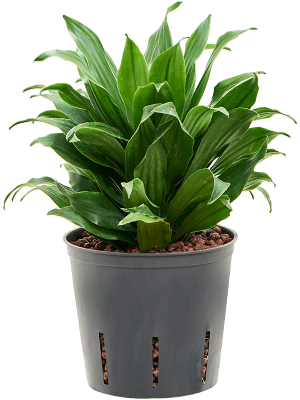
Dracaena fragrans 'Compacta'
Head
2DRCOKO10
The Dracaena is a very suitable office plant. With minimal, but correct, care you will keep the plant beautiful for a long time and full and fresh. Read more about the origin and care of this plant and view various species in both soil and hydroculture.
Origin of the Dracaena
The Dracaena belongs to the Agavaceae family and is found mainly in Africa and on the nearby islands. Although some species also grow in certain areas of Asia and Central America. The plant is also called Dragon's Blood Tree, which refers to the resin of the Dracaena variety that is bright red in colour. The Dracaena is a very strong plant, which can easily adapt to its location and needs little water. The plants are therefore very suitable for offices and other planting projects.
Dracaena species
There are many different species of which some 10 are known as house or office plants. Most Dracaena species have elongated, pointed leaves with a stripe or several stripes along the length of the leaf. The Dracaena Surculosa has dots on the leaves and there are also species with dark green leaves, which do well in shady places.

Position
Dracaenas are real shade plants. They need a maximum of 3 hours of direct sunlight per day. If the Dracaena is to be placed close to a window, it is advisable to start with this in the winter. Then the plant can be placed gradually closer to the window, so that in summer it can bear the direct sunlight. Colourful specimens such as the Dracaena (Pleomele) Song of India do like a sunny spot.
Watering
The amount of water depends on the temperature, the size of the plant and the light intensity. When growing in soil, there should not be a layer of water at the bottom of the pot; the soil must be able to absorb all the moisture. If the soil still feels damp after a few days, it is advisable to wait until it feels dry and give less water per watering session. In winter, watering the Dracaena once every 4-6 weeks is more than sufficient. In the summer, we recommend watering once every 2-3 weeks.

Discoloured leaves
In most situations, the colour of the leaves tells you what the plant needs. Brown spots with a yellow edge usually mean that the plant has received too much water. Yellow leaves are often the result of too much (direct) sunlight. If the Dracaena has curled leaves, this is a sign of dehydration. If you want to remove discoloured leaves from a Dracaena, there is a handy trick. Tear the leaf lengthwise and then pull it downwards from the stem. You will see that the wound dries up beautifully.